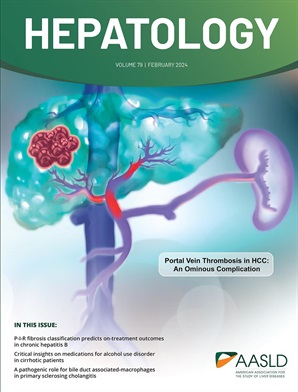Evaluating the positive predictive value of code-based identification of cirrhosis and its complications utilizing GPT-4
IF 12.9
1区 医学
Q1 GASTROENTEROLOGY & HEPATOLOGY
引用次数: 0
Abstract
Background: Diagnosis code classification is a common method for cohort identification in cirrhosis research, but it is often inaccurate and augmented by labor-intensive chart review. Natural language processing (NLP) using large language models (LLMs) is a potentially more accurate method. To assess LLMs’ potential for cirrhosis cohort identification, we compared code-based versus LLM-based classification with chart review as a “gold standard.” Methods: We extracted and conducted a limited chart review of 3,788 discharge summaries of cirrhosis admissions. We engineered zero-shot prompts using Generative Pre-trained Transformer (GPT)-4 to determine whether cirrhosis and its complications were active hospitalization problems. We calculated positive predictive values (PPVs) of LLM-based classification versus limited chart review, and PPVs of code-based versus LLM-based classification as a “silver standard” in all 3,788 summaries. Results: Versus gold standard chart review, code-based classification achieved PPVs of 82.2% for identifying cirrhosis, 41.7% hepatic encephalopathy, 72.8% ascites, 59.8% gastrointestinal bleeding, and 48.8% spontaneous bacterial peritonitis. Compared to chart review, GPT-4 achieved 87.8-98.8% accuracies for identifying cirrhosis and its complications. Using LLM as a silver standard, code-based classification achieved PPVs of 79.8% for identifying cirrhosis, 53.9% hepatic encephalopathy, 55.3% ascites, 67.6% gastrointestinal bleeding, and 65.5% spontaneous bacterial peritonitis. Conclusions: LLM-based classification was highly accurate versus manual chart review in identifying cirrhosis and its complications – this allowed us to assess the performance of code-based classification at scale using LLMs as a silver standard. These results suggest LLMs could augment or replace code-based cohort classification and raise questions regarding the necessity of chart review.利用 GPT-4 评估基于代码识别肝硬化及其并发症的阳性预测值
背景:在肝硬化研究中,诊断代码分类是一种常见的队列识别方法,但这种方法通常并不准确,而且还要通过劳动密集型的病历审查。使用大型语言模型(LLMs)进行自然语言处理(NLP)可能是一种更准确的方法。为了评估 LLMs 在肝硬化队列识别方面的潜力,我们将基于代码的分类与基于 LLM 的分类进行了比较,并将病历审查作为 "金标准"。方法:我们提取并对 3788 份肝硬化入院患者的出院摘要进行了有限的病历审查。我们使用生成预训练变换器(GPT)-4设计了零点提示,以确定肝硬化及其并发症是否为主动住院问题。我们计算了基于 LLM 的分类与有限病历审查的阳性预测值 (PPV),以及所有 3,788 份摘要中作为 "银标准 "的基于代码的分类与基于 LLM 的分类的 PPV。结果:与金标准病历审查相比,基于代码的分类在识别肝硬化、肝性脑病、腹水、消化道出血和自发性细菌性腹膜炎方面的 PPV 分别为 82.2%、41.7%、72.8%、59.8% 和 48.8%。与病历审查相比,GPT-4 在识别肝硬化及其并发症方面的准确率为 87.8%-98.8%。以 LLM 作为银标准,基于代码的分类在识别肝硬化、肝性脑病、腹水、消化道出血和自发性细菌性腹膜炎方面的 PPV 分别为 79.8%、53.9%、55.3%、67.6% 和 65.5%。结论在识别肝硬化及其并发症方面,基于 LLM 的分类与人工病历审查相比准确率很高,这使我们能够以 LLM 作为银标准,评估基于代码的大规模分类的性能。这些结果表明,LLM 可以增强或取代基于代码的队列分类,并提出了有关病历审查必要性的问题。
本文章由计算机程序翻译,如有差异,请以英文原文为准。
求助全文
约1分钟内获得全文
求助全文
来源期刊

Hepatology
医学-胃肠肝病学
CiteScore
27.50
自引率
3.70%
发文量
609
审稿时长
1 months
期刊介绍:
HEPATOLOGY is recognized as the leading publication in the field of liver disease. It features original, peer-reviewed articles covering various aspects of liver structure, function, and disease. The journal's distinguished Editorial Board carefully selects the best articles each month, focusing on topics including immunology, chronic hepatitis, viral hepatitis, cirrhosis, genetic and metabolic liver diseases, liver cancer, and drug metabolism.
 求助内容:
求助内容: 应助结果提醒方式:
应助结果提醒方式:


